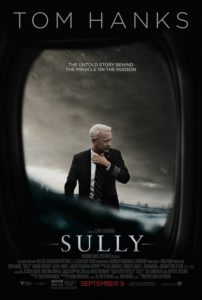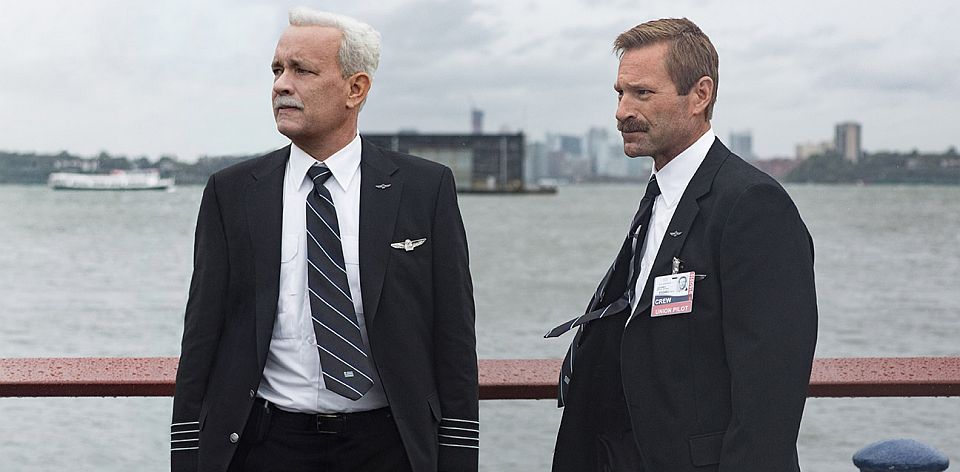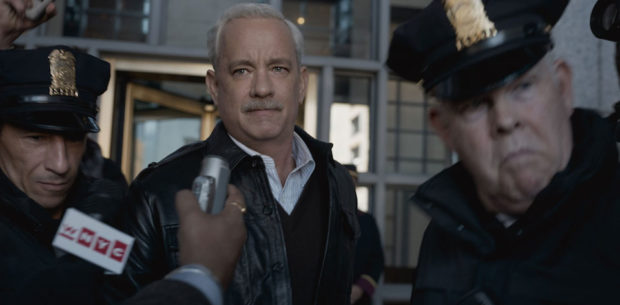Summary
As a straightforward retelling of a recent event, the focus is on the performances and the human factor that provides the variables in this well-documented near-tragedy.
 “It’s been a while since New York had news this good, especially with an airplane in it.” Watching the recreation of US Airways Flight 1549 veering through the buildings of New York City, it’s impossible not to be reminded of 9/11. In fact, it’s a parallel that director Clint Eastwood makes multiple times throughout SULLY, the biopic of the captain who safely landed a passenger jet in the Hudson River after losing both of its engines during takeoff. The incident was later dubbed “The Miracle on the Hudson,” although as this film sets out to prove, miracles don’t happen by themselves or without healthy doses of skepticism.
“It’s been a while since New York had news this good, especially with an airplane in it.” Watching the recreation of US Airways Flight 1549 veering through the buildings of New York City, it’s impossible not to be reminded of 9/11. In fact, it’s a parallel that director Clint Eastwood makes multiple times throughout SULLY, the biopic of the captain who safely landed a passenger jet in the Hudson River after losing both of its engines during takeoff. The incident was later dubbed “The Miracle on the Hudson,” although as this film sets out to prove, miracles don’t happen by themselves or without healthy doses of skepticism.
Eastwood wastes little time in showcasing the spectacular point-of-view shots of Captain Chesley “Sully” Sullenberger (Tom Hanks) and First Officer Jeff Skiles (Aaron Eckhart) as they steer the plane across the Manhattan skyline. Based partly on Sullenberger’s autobiography Highest Duty, Todd Komarnicki’s script spends its brief running time looking at the aftermath of the event, from the media frenzy to the formal investigation into the accident. Punctuated with formative moments from Sully’s life, and phone conversations with his wife Lorraine (Laura Linney), the film is an attempt to scratch beneath the public spectacle to some version of the objective “truth.”
Eastwood has a reputation for a point-and-shoot approach to filmmaking, but here the technique works to his advantage, laying out the facts and allowing us to judge them for ourselves. The film is one of numbers and facts, mostly uncomplicated by overt sentimentality. The overwrought emotions are certainly chomping at the bit to get out, and they do in the last act with gusto, but Eastwood keeps them restrained with a systematic checking off of the principal moments of public record. However, this does have the downside of being repetitive, as the 208 seconds of the crisis play out in a Rashōmon style of alternate perspectives.
As the outcome of the very recent events are well known to the public, the tension in the film comes from the stakes Sully and Skiles face if found responsible for the emergency landing. After 40 years on the job, Sully could potentially be retired without his pension. As such, the performances are key, and Hanks gives a transformative turn as the eponymous captain, wearing the weight of his burden on his moustached face. It’s a shame that formidable Linney is relegated to stay-at-home wife, but this is effectively a two-hander with the equally hirsute Eckhart.
Tom Stern, Eastwood’s regular cinematographer since Blood Work (2002), crafts some spectacular shots of New York, another major character in the film. Tasked with finding new ways of shooting the same 208 seconds several times over, close-ups in the cockpit, vignettes with selected passengers, long shots from New Jersey or bright neon vista of Times Square give the grey winter skylines a visual break and leaves the audience white-knuckling for the duration.
SULLY makes a careful declaration during its slightly trite and idealistic conclusion, noting that it was not Sullenberger alone who saved the 155 people on Flight 1549. Yet the film is named after the captain, as this is very much an essay on what one human can do in the face of catastrophe. Crafted as a optimistic alternative to the historic tragedy that befell New York this century, SULLY works best as an intense character study.
2016 | US | DIR: Clint Eastwood | WRITERS: Todd Komarnicki | CAST: Tom Hanks, Aaron Eckhart, Laura Linney | DISTRIBUTOR: Roadshow Films (AUS) | RUNNING TIME: 96 minutes | RELEASE DATE: 8 September 2016 (AUS), 9 September 2016 (US)





